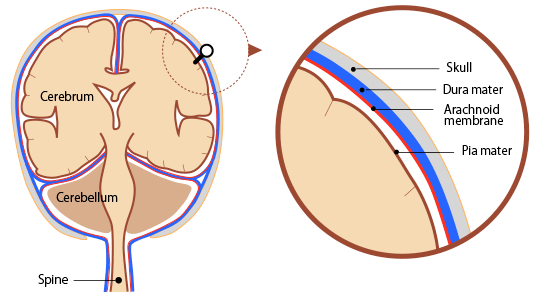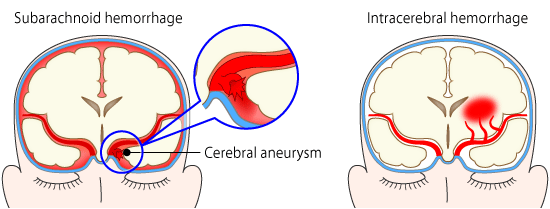- HOME
- For Patients
- Subarachnoid hemorrhage
Subarachnoid hemorrhage
- About subarachnoid hemorrhage
- Symptom of subarachnoid hemorrhage
- Cause of subarachnoid hemorrhage
- Diagnosis of subarachnoid hemorrhage
- Treatment of subarachnoid hemorrhage
About subarachnoid hemorrhage
Hemorrhage from a cerebral aneurysm
Subarachnoid hemorrhage refers to hemorrhage beneath the arachnoid mater, one of the membranes covering the surface of the brain. In most cases, subarachnoid hemorrhage is caused by the rupture of a cerebral aneurysm, an abnormal swelling of one of the blood vessels in the brain. The arachnoid mater is one of the three membranes that protect the brain (from the outside, these comprise the dura mater, arachnoid mater, and pia mater). The feeding arteries that supply the brain with blood run between the arachnoid mater and the brain (in the subarachnoid space), and a clear, colorless, protective fluid called cerebrospinal fluid also circulates through this space.
[ Three layers of membrane covering the brain surface ]


Under the skull, the brain surface is covered by 3 membrane layers: dura mater,
arachnoid membrane, and pia mater.
The brain is supplied by a very large number of blood vessels in comparison to its size. Unlike many other organs, comparatively thick feeding vessels run along the brain's surface (in the subarachnoid space). Some of these vessels are responsible for penetrating the brain and supplying blood to its interior.
When one of the blood vessels running through this space between the arachnoid membrane and brain (the subarachnoid space) ruptures, it causes a subarachnoid hemorrhage. This results in blood mixing with the cerebrospinal fluid that flows through the subarachnoid space.
"Intracerebral hemorrhage" is another condition that involves hemorrhage in the head. Unlike subarachnoid hemorrhage, intracerebral hemorrhage involves the breakage of one of the fine vessels that penetrates and transports blood to the inside of the brain, resulting in hemorrhage.
[ Difference of blood clot location between subarachnoid hemorrhage and intracerebral hemorrhage ]








